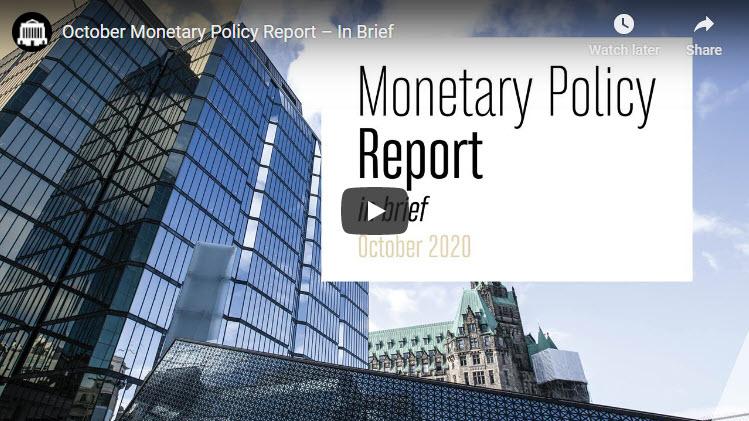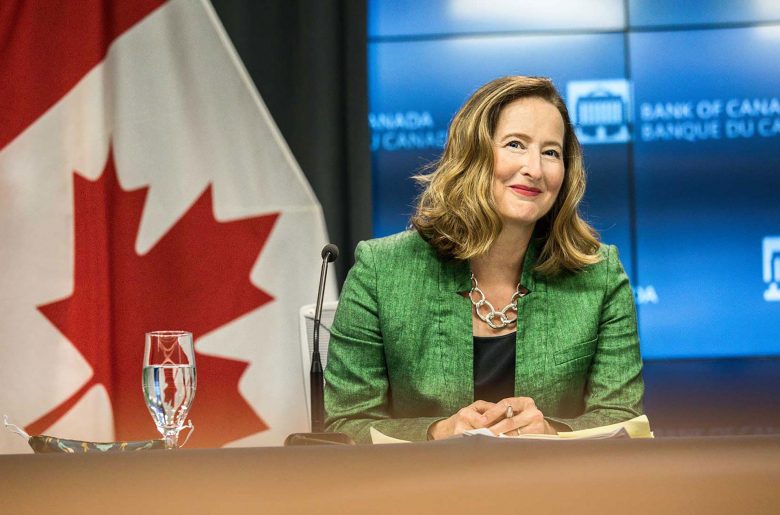
Monetary policy
Like other economies around the world, the Canadian economy was hit hard by COVID‑19. Following the onset of the pandemic and the introduction of measures to contain its spread, gross domestic product (GDP) fell by more than 10 percent in the first half of 2020.
Roughly half of that drop was recovered in the third quarter. But subsequent growth slowed significantly as the initial boost from reopening the economy faded. Moreover, rising numbers of COVID‑19 cases in the autumn and winter led governments to tighten physical distancing measures, weighing on the recovery.

https://www.youtube.com/watch?v=zjJ3K3lp8zU
Assessing and responding to the effects of the pandemic
The pandemic had highly uneven effects across businesses1 and people.2
- Sectors that require social proximity—such as accommodation, food and restaurants—were hit hardest. Youth, low-wage workers and women were disproportionately affected because they often work in these sectors.
- Other sectors, such as goods and housing, fared better, helped by policy support and shifts in consumer preferences during the pandemic.
Government programs provided significant support to businesses and households.
Economic activity fell significantly as a result of the pandemic.3 While it partially rebounded through the summer as businesses reopened, growth then slowed due to ongoing adverse effects of the pandemic, including containment measures, elevated uncertainty, and suppressed business and consumer confidence.
Consumer price index (CPI) inflation was at the bottom of or below the Bank’s 1 to 3 percent target range from March through to the end of the year, consistent with an economy operating with considerable economic slack.
ICYMI: Deputy Governor Schembri said the second phase of the economic recovery could be bumpy: after an initial bounceback, the speed, strength and breadth of recovery are harder to predict. #economy #COVID19 #cdnecon http://ow.ly/b03b50AbErj pic.twitter.com/1273692467699879936
— Bank of Canada (@bankofcanada) July 18, 2020

https://twitter.com/bankofcanada/status/1273692467699879936
| Achievement of target for CPI inflation | ||||||
| Key indicators | Reference level | 2016 | 2017 | 2018 | 2019 | 2020 |
| CPI inflation | 2,0 | 1.4 | 1.6 | 2.3 | 1.9 | 0.7 |
| Average CPI inflation since 2001 | 1.8 | |||||
| Inflation expectations at a 10-year horizon | 2,0 | 2.0 | 2.0 | 2.0 | 2.0 | 2.0 |
The Bank took swift and decisive actions to help cushion the impact of the pandemic on the Canadian economy by:
- launching liquidity facilities and support programs early in the pandemic to support financial market functioning (some of these were discontinued as market functioning improved)
- lowering its target for the overnight rate to 0.25 percent in March 2020 and signalling in July—through extraordinary forward guidance4—that it would keep rates there until economic slack is absorbed and the 2 percent inflation target is sustainably achieved
- supplementing and reinforcing the rate cuts and forward guidance through a quantitative easing program5 to keep interest rates low
Low borrowing costs and well-functioning financial markets helped businesses adjust to the pandemic and supported household spending.
Supporting the Bank’s monetary policy function
Timely and thorough analysis supported monetary decisions in many ways throughout the year.
Bank staff mapped out a range of possible economic outcomes, which helped shape the narrative in the April Monetary Policy Report.6 As extreme uncertainty abated, they moved first to a central scenario and then back to a full projection.
The Bank collaborated with Statistics Canada to create an adjusted CPI to account for changes in consumption patterns due to the pandemic.7
Given how quickly the pandemic unfolded within Canada and globally—and how uneven its impact was—researchers relied on new forms of highly granular data to understand its economic impact. Staff added high-frequency data—ranging from restaurant reservations to transit ridership and payments information—to existing data sources. These data helped staff to:
- better assess the economic impact of the pandemic
- track how quickly global activity was coming back online when economies started to reopen
The use of such data is not new to the Bank. But lags in the publication of traditional data and the rapidly changing economic environment made these data all the more valuable in the policy-making process. Staff also expanded their use of surveys to better understand how the pandemic was affecting firms8 and consumers.9
Finally, staff continued working toward the renewal of the monetary policy framework—set to occur in 2021. Preliminary analysis compared several alternative policy regimes, weighing the relative benefits of each. A virtual conference collected input from external experts and explored lessons learned from the pandemic.10 (See Consulting with Canadians on inflation control for more information.) Staff also collaborated with Statistics Canada on a workshop on CPI measurement issues and the gap between perceived and actual inflation.
Looking forward
In 2021, the Bank will dedicate significant resources to further analyzing the effects of the pandemic on the economy. In addition, the Bank will:
- complete work related to renewing the monetary policy framework and publish research comparing the relative performance and strength of several alternative approaches to monetary policy
- continue to develop macroeconomic models that capture the complex relationship between monetary policy and the financial system
- analyze the structural changes to the economy resulting from digitalization, the pandemic, population aging and climate change, and consider their implications for monetary policy
- continue to explore opportunities to enhance the Bank’s economic models by incorporating new data sources and machine-learning techniques into economic forecasts and projections
- 1. Lawrence L. Schembri, “Our COVID‑19 Response: Navigating Diverse Economic Impacts," Bank of Canada The Economy, Plain and Simple (June 30, 2020).[←]
- 2. Tiff Macklem, “Economic Progress Report: A Very Uneven Recovery” (remarks to the Canadian Chamber of Commerce, Ottawa, Ontario, September 10, 2020).[←]
- 3. Supply was also adversely affected by the pandemic. For details see: Dany Brouillette, Julien Champagne and Julien Mc Donald-Guimond, “Potential Output in Canada: 2020 Reassessment,” Bank of Canada Staff Analytical Note No. 2020-25 (October 2020).[←]
- 4. Bank of Canada, “Bank of Canada Will Maintain Current Level of Policy Rate Until Inflation Objective Is Achieved, Recalibrates Its Quantitative Easing Program,” press release (October 28, 2020).[←]
- 5. Paul Beaudry, “Our COVID‑19 Response: Large-Scale Asset Purchases,” Bank of Canada The Economy Plain and Simple (August 25, 2020).[←]
- 6. Bank of Canada, Monetary Policy Report (April 2020).[←]
- 7. Kim Huynh, Helen Lao, Patrick Sabourin and Angelika Welte, “What Do High-Frequency Expenditure Network Data Reveal About Spending and Inflation During COVID‑19?” Bank of Canada Staff Analytical Note No. 2020-20 (September 2020).[←]
- 8. Bank of Canada, “Box 1: Flexible logistics solutions are helping manage supply chain challenges,” Business Outlook Survey—Autumn 2020 (October 19, 2020).[←]
- 9. Bank of Canada, Canadian Survey of Consumer Expectations—Third Quarter of 2020 (October 19, 2020).[←]
- 10. Bank of Canada, “Towards the 2021 Renewal of the Bank of Canada’s Monetary Policy Framework (Webcast)” (August 26, 2020).[←]
